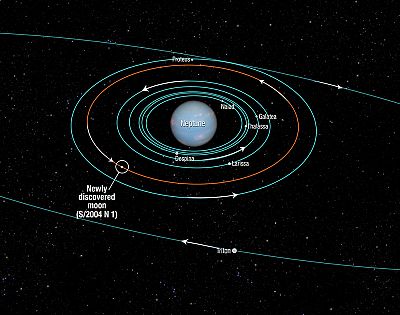Hippocamp is thought to be a fragment of a neighboring moon shattered by the impact of a comet.
Say hello to Hippocamp, a celestial pipsqueak that's making big waves at the edge of our solar system. With help from NASA's Hubble Space Telescope, astronomers have confirmed the existence of thistiny moon in orbit around Neptune.
With a diameter of only 20 miles, the newly characterized moon — named after a mythical half-horse, half-fish sea creature — is the smallest moon yet discovered in orbit around the outermost planet. NASA says it's about 100 million times fainter than the faintest star that's visible to the naked eye.
Hippocamp was first seen in photos taken by Hubble in 2013. But its presence — situated close to a much larger moon known as Proteus — posed a mystery: Why hadn't Hippocamp coalesced with or been cast aside by Proteus, an irregularly shaped, 260-mile-wide moon that is roughly 1,000 times more massive?
Some called S/2004 N1, as Hippocamp was originally known, "the moon that shouldn't be there."
But after several years of sleuthing — including a fresh look at photos of the Neptune system taken by Hubble and NASA's Voyager 2 spacecraft — astronomers led by Mark Showalter of the SETI Institute in Mountain View, California, determined that Hippocamp is a piece of Proteus that had been sheared off from the larger moon when a comet struck it billions of years ago.
Space
There's no smoking gun for a collision so ancient. But as Showalter and his colleagues say in a paper about their research, published Thursday in the journal Nature, a large impact crater consistent with a comet strike can be seen in photos of Proteus taken in 1989 by NASA's Voyager 2 spacecraft.
"The origin scenario we discussed in the paper is consistent with everything we know about the history of the Neptune system," Showalter told NBC News MACH in an email. "It is the only workable scenario that we have identified. On the other hand, if somebody else in the astronomy community comes up with an alternative explanation, we would love to hear about it."
It's a big backstory for such a puny moon, but other astronomers agree it's probably the correct one.
Sara Seager, a planetary scientist at MIT in Cambridge, Massachusetts, said in an email that the explanation made sense. She called it "a fascinating hypothesis for the tiny moon's origin — with solid support from Hubble data gathered over the last few years."
Hundreds of moons have been found in our solar system. But the Proteus-Hippocamp pair "provides a dramatic illustration that moons are sometimes broken apart by comets," Jack Lissauer, a scientist at NASA's Ames Research Center in Mountain View, California, and a coauthor of the paper, said in a written statement.
The discovery of Hippocamp brings to 14 the number of moons discovered in orbit around Neptune. There are seven inner moons, including Hippocamp, along with six outer moons and Neptune's largest moon, Triton.
Triton is a bit of an oddball because it's the only moon in the solar system with a so-called retrograde orbit, meaning it orbits in the opposite direction of its planet's rotation.
Showalter said that we've learned just about all we can about Hippocamp, at least for the time being. But he added that if NASA or the European Space Agency were to put a spacecraft in orbit around Neptune or its planetary neighbor, Uranus, "we could learn more in a few days that the sum total of everything we have ever learned about either planet so far!"












